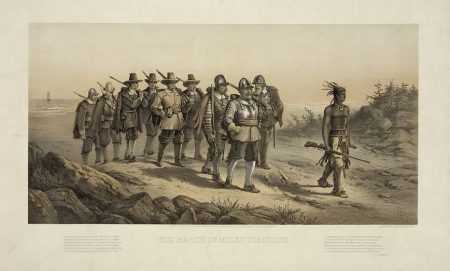
If you have read even a little about the Pilgrims, you will have heard that Captain Myles Standish, their military commander, was a “stranger,” not a member of the church from Leiden and Scrooby, and that he never joined the Pilgrim church. I’ve said this myself in a lecture before, and it’s a fact that you will find in many authoritative books on the Pilgrims. But what if it is not true? Let’s look at the evidence.
A Secret Catholic?
One claim that is made by some Catholics is that Standish was actually a secret Catholic.[1] This can be dismissed in pretty short order. Their main argument is based on which of the Standish familes he may have come from. That is an open question, but I would argue that it proves nothing. The fact that he came from a Catholic family does not mean that he was a Catholic, there were many converts to Protestantism. The fact that he chose to travel and settle with the Separatists, on the farthest spectrum of anti-Catholics, is a far stronger argument that he was Protestant.
Puritan Sympathizer
In my earlier research, I found strong evidence that he was a Puritan sympathizer. Beyond his choice to settle with them, his inventory of his goods at his death includes Calvin’s Institutes and books by Puritans such as Jeremiah Burroughs and John Dod.[2] It does seem that he knew John Robinson, the pastor of the Pilgrim church in Leiden who died before he was able to come to New England. Robinson called him “Captain whom I love” and Standish left money to Mercy Robinson, “whome I tenderly love for her Grandfathers sacke.”[3] It is likely that Standish came in contact with the Pilgrim church while he was serving as a soldier in the Netherlands.
His Church Membership
But what of his supposed failure to join the Pilgrim church? As it turns out, there are no survival membership records from this time, and therefore there is no evidence that he was not a member. His refusal to join was invented by historians based on an absence of evidence, and the same argument could be made for nearly any Pilgrim. The late Jeremy Bangs, one of the greatest Pilgrim scholars of recent years, put it this way in a thorough article on the subject:
A couple of reasons could account for the absence of Standish’s name in the Plymouth church records, without proving he was not a member. The first is fairly simple: there are no lists of communicants. Standish moved to Duxbury about forty years before the Plymouth church records in fact begin. He died eleven years before the first entries. … Other Plymouth colonists who did not move away from Plymouth were members of the congregation and are not recorded in the Plymouth church records as having joined. In point of fact, everyone from the Leiden congregation who moved to Plymouth continued as a member of the church without any of them having to “join” and be recorded as doing so. … Because no records are preserved from the Leiden congregation as a whole … there is no church-book record of any individual member’s participation…. If Myles Standish was an ordinary member of the Leiden congregation, he would not have “joined” the church in Plymouth or in Duxbury. …
Only after 1841 did the imaginary Standish become the trusty, courageous, romantic outsider, eventually to figure prominently among [the] fictive “Strangers.” In contrast to that stereotype, we must conclude that there is no evidence that Standish was not a member of the Pilgrim congregation, and that there are several circumstances strongly suggesting that he was a member.[4]
Bangs also examines where the myth comes from, likely due to a misreading of some of the early histories.
This is one of countless examples where myths have crept into the historical record, and although all the evidence to debunk them is readily available, they continue to get repeated and incorporated into historical narratives due to shoddy research practices (mine included). While getting a fact like this wrong may seem of little importance, as you add mistake upon mistake, and extrapolate from them, you can end up with very distorted version of what actually happened in the past.
1. Declan Leary, “Myles Standish, the Catholic Pilgrim” in Crisis Magazine (December 7, 2020) https://crisismagazine.com/opinion/myles-standish-the-catholic-pilgrim accessed January 11, 2024.
2. “The inventory of Myles Standish” https://pilgrimhall.org/pdf/Myles_Standish_Will_Inventory.pdf accessed January 11, 2024, p. 2-3.
3. David Beale, “Captain Myles Standish:Separatist Pilgrim, or Roman Catholic Soldier of Fortune?” in Faith Pulpit (Faith Baptist Theological Seminary, November, 2001) https://faithpulpit.faith.edu/posts/captain-myles-standish-separatist-pilgrim-or-roman-catholic-soldier-of-fortune accessed January 11, 2024.
4. Jeremy Dupertuis Bangs, “Myles Standish, Born Where? The State of the Question” in Mayflower Quarterly 72(2006), p. 133-159. https://sail1620.org/Myles_Standish_Born_Where, accessed January 11, 2024.




